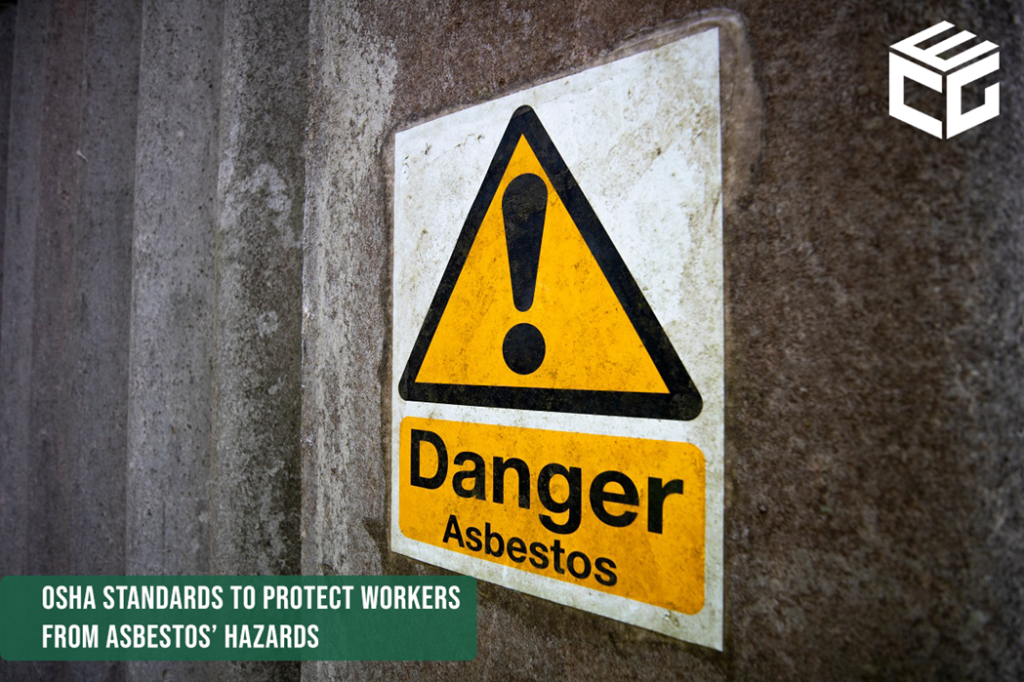OSHA STANDARDS TO PROTECT WORKERS FROM ASBESTOS’ HAZARDS
Asbestos is a naturally occurring mineral fiber. It was used in numerous building materials and vehicle products for its strength and ability to resist heat and corrosion before its dangerous health effects were discovered. Individual asbestos fibers cannot be seen by the naked eye, which puts workers at an increased risk. The Occupational Safety and Health Administration (OSHA) has regulations to protect workers from the hazards of asbestos.
What is the hazard?
Asbestos fibers are released into the air during activities that disturb asbestos-containing materials. The asbestos fibers can then be inhaled without knowing and trapped in the lungs. If swallowed, they can become embedded into the digestive tract as well. Asbestos is a known human carcinogen and can cause chronic lung disease as well as lung and other cancers. Symptoms and/or cancer may take many years to develop following exposure.
Where is the hazard?
The hazard may occur during manufacturing of asbestos-containing products; performing brake or clutch repairs; renovating or demolishing buildings or ships; or cleanup from those activities; contact with deteriorating asbestoscontaining materials and during cleanup after natural disasters. Some materials are presumed to contain asbestos if installed before 1981. Examples of these materials, as well as other presumed asbestos-containing materials are:
• Thermal system insulation
• Roofing and siding shingles
• Vinyl floor tiles
• Plaster, cement, putties and caulk
• Ceiling tiles and spray-on coatings
• Industrial pipe wrapping
• Heat-resistant textiles
• Automobile brake linings and clutch pads
OSHA Standards
OSHA has three standards to protect workers from the hazards of asbestos depending on the type of workplace. For complete information on all of the requirements, see the standard specific to your type of workplace: General Industry: 29 CFR 1910.1001 covers work in general industry, such as exposure during brake and clutch repair, maintenance work, and manufacture of asbestos-containing products. Shipyards: 29 CFR 1915.1001 covers construction, alteration, repair, maintenance, renovation and demolition of structures containing asbestos during work in shipyards. Construction: 29 CFR 1926.1101 covers construction, alteration, repair, maintenance, or renovation and demolition of structures containing asbestos.
What protections exist in the Standards?
• Permissible Exposure Limit (PEL) for asbestos is 0.1 fiber per cubic centimeter of air as an eight-hour time-weighted average (TWA), with an excursion limit (EL) of 1.0 asbestos fibers per cubic centimeter over a 30-minute period. The employer must ensure that no one is exposed above these limits.
• Assessment of workplaces covered by the standards must be completed to determine if asbestos is present and if the work will generate airborne fibers by a specific method under each standard.
• Monitoring necessary to detect if asbestos exposure is at or above the PEL or EL for workers who are, or may be expected to be exposed to asbestos. Frequency depends on work classification and exposure. The construction and shipyard standards require assessment and monitoring by a competent person. If the exposure has the potential to be above the PEL or EL, employers must use proper engineering controls and work practices to the extent feasible to keep it at or below the PEL and EL. Where feasible engineering controls and work practices do not ensure worker protection at the exposure limits, employers must reduce the exposures to the lowest level achievable and then supplement with proper respiratory protection to meet the PEL. The construction and shipyard standards contain specific control methods depending on work classification, and the general industry standard has specific controls for brake and clutch repair work.
• Proper hazard communication and demarcation with warning signs containing specified language in areas that have exposures above the PEL or EL is necessary. No smoking, eating, or drinking should occur in these areas and proper PPE must be provided and used to prevent exposure.
• Separate decontamination and lunch areas with proper hygiene practices must be provided to workers exposed above the PEL to avoid contamination.
• Training requirements depend on the workplace exposure and classification. Training must be provided to all workers exposed at or above the PEL before work begins and yearly thereafter. All training must be conducted in a manner and language in which the worker is able to understand. Workers who perform housekeeping operations in buildings with presumed asbestos containing materials but not at the PEL must also be provided asbestos awareness training.
• Medical surveillance requirements are different depending on the industry. Medical surveillance must be provided for workers who engage in certain classifications of work, or experience exposures at or above the PEL in construction and shipyards. In general industry, medical examinations must be provided for workers who experience exposure at or above the PEL.
• Records must be kept on exposure monitoring for asbestos for at least 30 years, and worker medical surveillance records retained for the duration of employment plus 30 years. Training records must be kept for at least 1 year beyond the last date of employment.
As you may realize, all contractors must be aware of these standards and positively comply with them. At Environmental Construction Group, we take safety as our priority.
We are ECG, we are safety first.
This field definitely needs some expert hands and skill. So, have you decided on what type of project you need? Make sure you research on this for a while before coming up with a decision.
We pride ourselves in providing Demolition, Abatement and Environmental Services you can depend on. (Concrete cutting, coring, green demolition, disinfection and sterilization cleaning services, asbestos abatement and more)
Contact us to get started on your next project, Call us: 562-438-7999.





